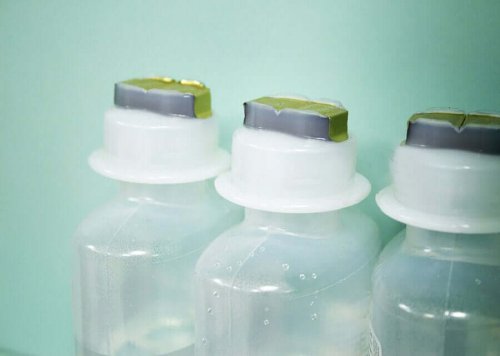What’s Saline Solution Used For?


Written and verified by the doctor Leonardo Biolatto
People also know saline solution simply as “saline”. It’s a simple preparation you can even make at home. Although experts have questioned it, its usefulness in medicine is virtually indisputable.
Saline solution consists of water and salt. That’s where its simplicity lies, as well as the ability to make it at home. The concentration of this solution is 0.9%, which implies that it has the same concentration as human blood.
As the concentrations are the same, it’s an isotonic preparation. This means that neither blood nor saline solution is more concentrated than the other. Because of this characteristic, it’s safe to use in the human body.
The preparation was invented in 1896. Dutch scientist Hartog Jacob Hamburger prepared it for use in hemolysis research. Its inventor didn’t intend to give it a medical use. However, it eventually acquired this use.
Uses of saline solution
Saline solutions have many applications. You can use it both externally and internally, by injecting it into the circulatory system. Here are the most common uses:
- Eyewash and contact lenses. For this use, experts suggest the liquid to be sterile so the eyes nor the lenses suffer bacterial invasion. Usually, saline solution for the eyes comes in small bottles you can buy in pharmacies.
- Cleaning wounds. This is one of the most-used liquids to clean wounds. Along with other antiseptic agents, it helps prevent infections.
- Nasal use. This is for a stuffy nose or excessive mucus in the upper airway. It can be applied through syringes or inhalers. Saline water drags secretions through gravity. Also, experts recommend it to patients suffering from rhinitis and nasal congestion due to allergies. Not only does it drag secretions, but also allergenic substances. Finally, after nose surgery, doctors recommend it as part of the subsequent antisepsis.
- Hydration. When the human body is dehydrated or hypotensive due to fluid loss, saline is a good substitute for what was lost. Generally, in these cases, it’s administered intravenously at a fast rate. Thus, it’s useful in cases of severe gastroenteritis, profuse hemorrhages, and extensive burns.
- Nebulization. The preparation is poured into the nebulizer to create a mist that will enter the airways. Patients who are suffering from flu, sinus infections, and bronchitis can benefit from it.

Keep reading: How to Make Homemade Electrolyte Beverage to Prevent Dehydration
Forms of presentation
You can find saline solutions in different forms:
- Vials. They’re small and sterile while they’re closed. You can easily transport them anywhere. Once open, they’re no longer sterile. However, they’re so small that, in most cases, they don’t last more than one use.
- Drops. For ocular use and nebulization.
- Spray. Possibly with the primary goal of favoring nasal irrigation. You can find them in pharmacies. Like vials, you can easily transport them everywhere.
- Bottles. They’re bigger presentations for other applications that require large volumes of liquid. For example, to wash a wound or burn.
- Intravenous containers. They come in different sizes and you can find them in hospital settings. The container is attached to a tube with a syringe at the end, which a medical professional inserts into the patient’s vein. It allows you to hydrate the patient and facilitates medication management.

Find out more here: What’s Aerosol Therapy?
Homemade saline solution
As we explained above, you can make your own saline solution at home. It may be useful to do it for something specific, such as cleaning a scar that you previously disinfected. However, you need to remember that the solution won’t be sterile.
To make your own, pour a teaspoon of common salt into 250 cubic centimeters of water. Follow the same ratio to make more if necessary. Then, you can store the preparation in clean jars. It only lasts 48 hours. Thus, after that time, you must dispose of it.
You can store it at room temperature or in a refrigerator. Experts haven’t concluded that either method prolongs its useful life. Remember that room temperature refers to temperate climate, not tropical climate nor extreme heat.
Now that you discovered the amazing characteristics of saline solution, you can use it without fear if you ever need it. It’s a very useful and simple solution that can even save lives in extreme cases.
All cited sources were thoroughly reviewed by our team to ensure their quality, reliability, currency, and validity. The bibliography of this article was considered reliable and of academic or scientific accuracy.
- Silva, L. Dopico, and F. Oliveira Tinoco. “Recomendaciones para el empleo de solución salina 0, 9% en catéteres venosos periféricos.” Enfermería Global 6.2 (2007).
- Trujillo-Zea, Jorge Alejandro, Natalia Aristizábal-Henao, and Nelson Fonseca-Ruiz. “Lactato de Ringer versus solución salina normal para trasplante renal. Revisión sistemática y metaanálisis.” Revista Colombiana de Anestesiología 43.3 (2015): 194-203.
- Rojas, César A. “La solución salina fisiológica y su alta concentración de cloruro.” Ciencia e Investigación 22.1 (2019): 27-30.
This text is provided for informational purposes only and does not replace consultation with a professional. If in doubt, consult your specialist.








